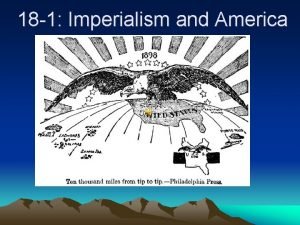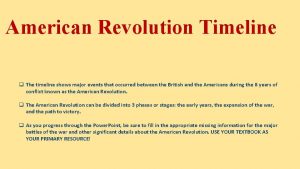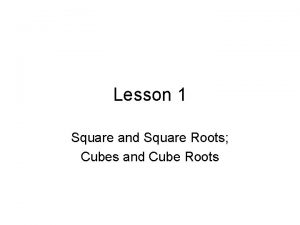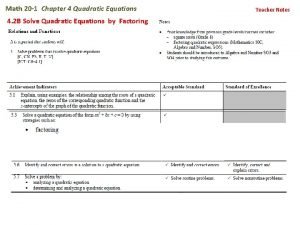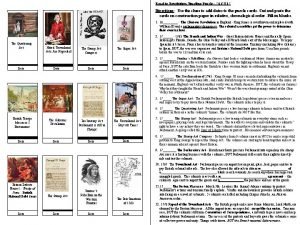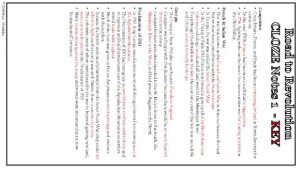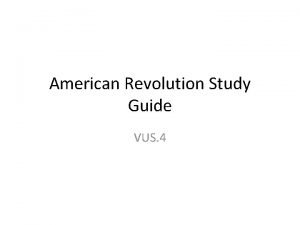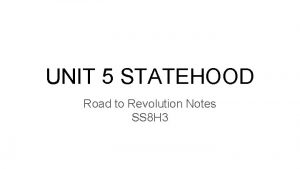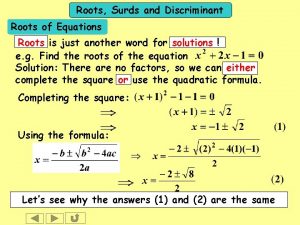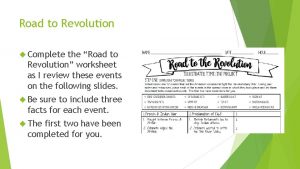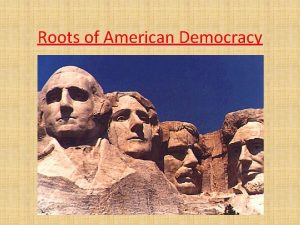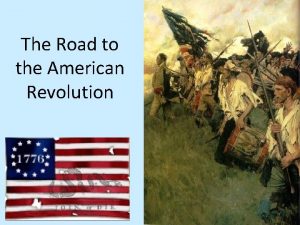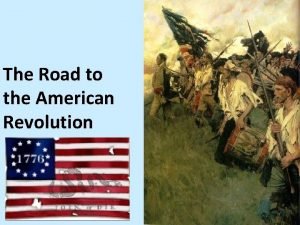Road to the American Revolution Roots of American












- Slides: 12

Road to the American Revolution

Roots of American Democracy ! • The traditions of British law and the Enlightenment guided the development of the early American colonies and the founding of the United States. • British Traditions: – Magna Carta (1215) – right to trial by jury, due process of law, no taxation without representation, habeas corpus – English Common Law - based on custom and court decisions – English Bill of Rights (1689) – limited power of king and gave people more rights • Enlightenment Ideas: – Social Contract Theory (Rousseau) – government comes from the consent of the governed – Natural Rights (Locke) – life, Liberty, and property – Separation of Powers (Montesquieu) – 3 branches of government.

Self-Government in the Colonies • Colonial documents led to the establishment of a limited government, majority rule, direct democracy, and civil liberties (political rights) in North America. – Virginia House of Burgesses (1619) = first representative assembly in colonies. – Mayflower Compact (1620) = first form of direct democracy in North America.

Britain’s American Colonies • Throughout the 1600 s and 1700 s, the thirteen English colonies along the eastern coast thrived. – Population grew by leaps and bounds • 250, 000 in 1700 to 2, 150, 000 in 1770 – Economy prospered • Traded with Europe – remember Triangular Trade? ? • New sense of an “American” identity – Colonists had been living in America for 150 years – Each colony had its own government and a large degree of independence – Colonists saw themselves as less British and more as Virginians or North Carolinians. • Many actions taken by the British began to irritate the colonists and tensions grew…

Navigation Acts (1651) • Navigation Acts (1651) – colonies of Great Britain could ONLY trade with the mother country. – Designed to keep trade in England support Mercantilism. • Mercantilism = economic theory where you sell (export) more than you buy (import) – Britain bought American raw materials (ex. cotton) for low prices and sold manufactured goods (ex. cloth) back to the colonists. – All colonial ships had to stop in an English harbor before going on to another country • Led to period of Salutary Neglect – Britain did not pay too close attention to its colonies – Colonists enjoyed free period of self-government

French and Indian War (1754) • French and Indian War (1754 – 1763) ~ fought between the English and the French over lands in North America. – French (and Native American tribes) vs. Great Britain – British win! – Treaty of Paris (1763) = ended the war and made England the dominant power in North America. France had to give up most of its land in North America

Proclamation of 1763 • Victory in the French and Indian War led to increased tension between Britain and its colonist. • Under the Treaty of Paris Britain claimed land east of the Mississippi River – Proclamation of 1763 ~ prohibited colonists from settling west of the Appalachian Mountains(to ease tensions with Native Americans) – Angered colonists and increased their independent spirit!

More Trouble…TAXES! • In order to fight the French and Indian War, Great Britain had run up a huge debt. – To pay for the war, Great Britain started taxing the colonists. – Ended Period of Salutary Neglect • British Parliament began passing tax laws – Stamp Act, Quartering Act, Townshend Acts, Tea Act, Intolerable Acts • Colonists were outraged and began to protest. – “No Taxation without Representation”

Cartoon Analysis Questions • What do you see? (Students should simply point out all symbols, characters, objects, text, etc. that they notice. Try to keep them from jumping to interpretation until all pieces of the cartoon are pointed out. ) • What do you think? What message is the artist trying to convey? What do the symbols represent? • What techniques has the artist used and why? (exaggeration, caricatures, humor, sarcasm, etc. ) • If you were an American Patriot, would you agree with the cartoonist? Why? • If you were a Loyalist, would you agree with the cartoonist? Why?

Political Cartoon Analysis

Revolutionary Political Cartoons • You are going to create a political cartoon that illustrates an event, tax, act, or law that led to the outbreak of the Revolutionary War. • Your cartoon must illustrate: – The key ideas of your event, tax, or act – How your event, tax, or act led to the American Revolution. • “A” quality will include: – Be sure to have a clear message about your event, tax, act, or law. – Use characters, symbolism, objects, text to convey your message. – Also use caricature, exaggeration, humor and sarcasm in your cartoon! Good Luck

 Economic roots of american imperialism
Economic roots of american imperialism Road to american revolution timeline
Road to american revolution timeline How could the french revolution been avoided
How could the french revolution been avoided Vanessa jason
Vanessa jason Perfect squares list
Perfect squares list Perfect squares
Perfect squares Existence and uniqueness of square roots and cube roots
Existence and uniqueness of square roots and cube roots Roots of a quadratic equation
Roots of a quadratic equation What is paved and unpaved road
What is paved and unpaved road Road to revolution timeline answers
Road to revolution timeline answers Colonial georgia cloze notes
Colonial georgia cloze notes Road to revolution study guide answer key
Road to revolution study guide answer key American revolution cloze notes 1
American revolution cloze notes 1
